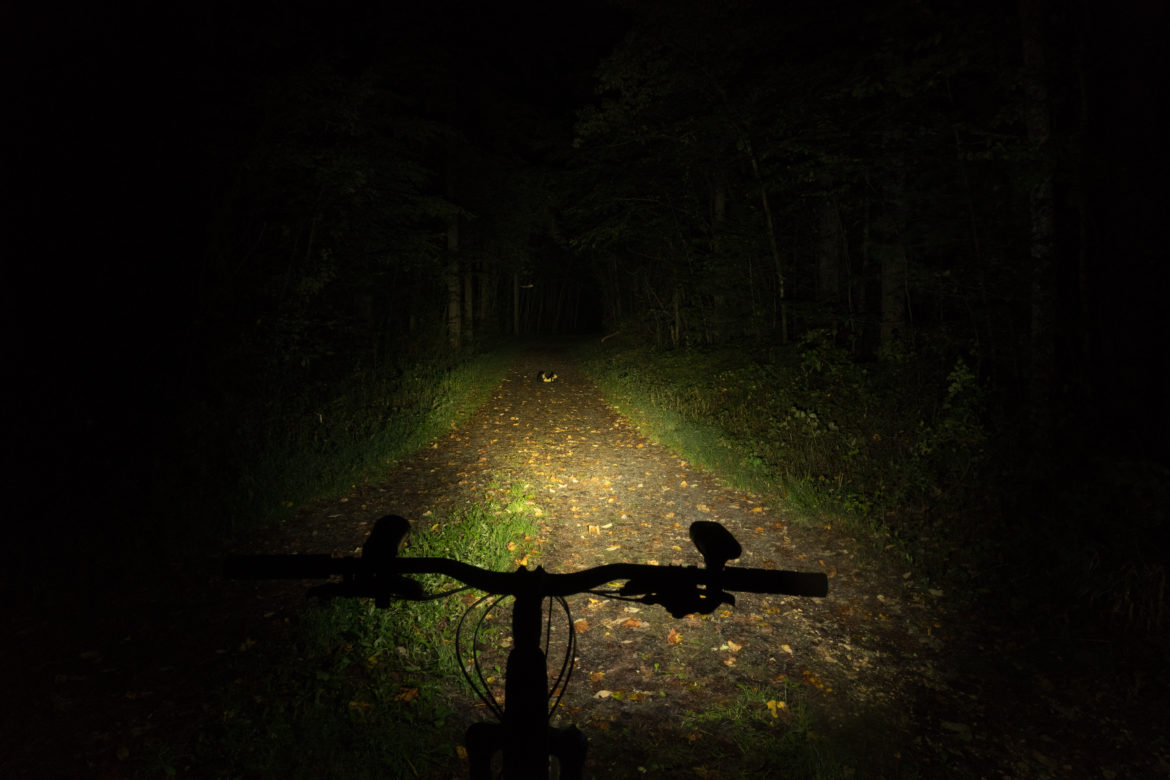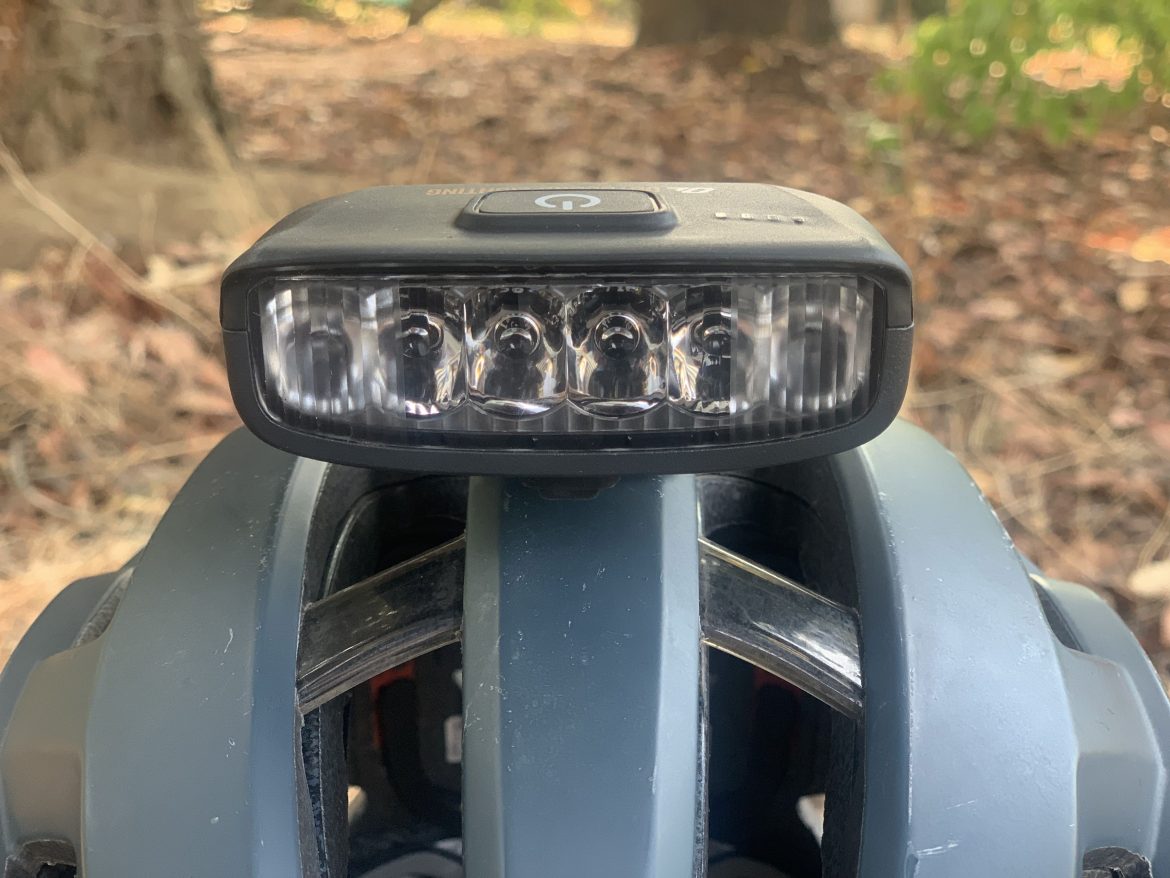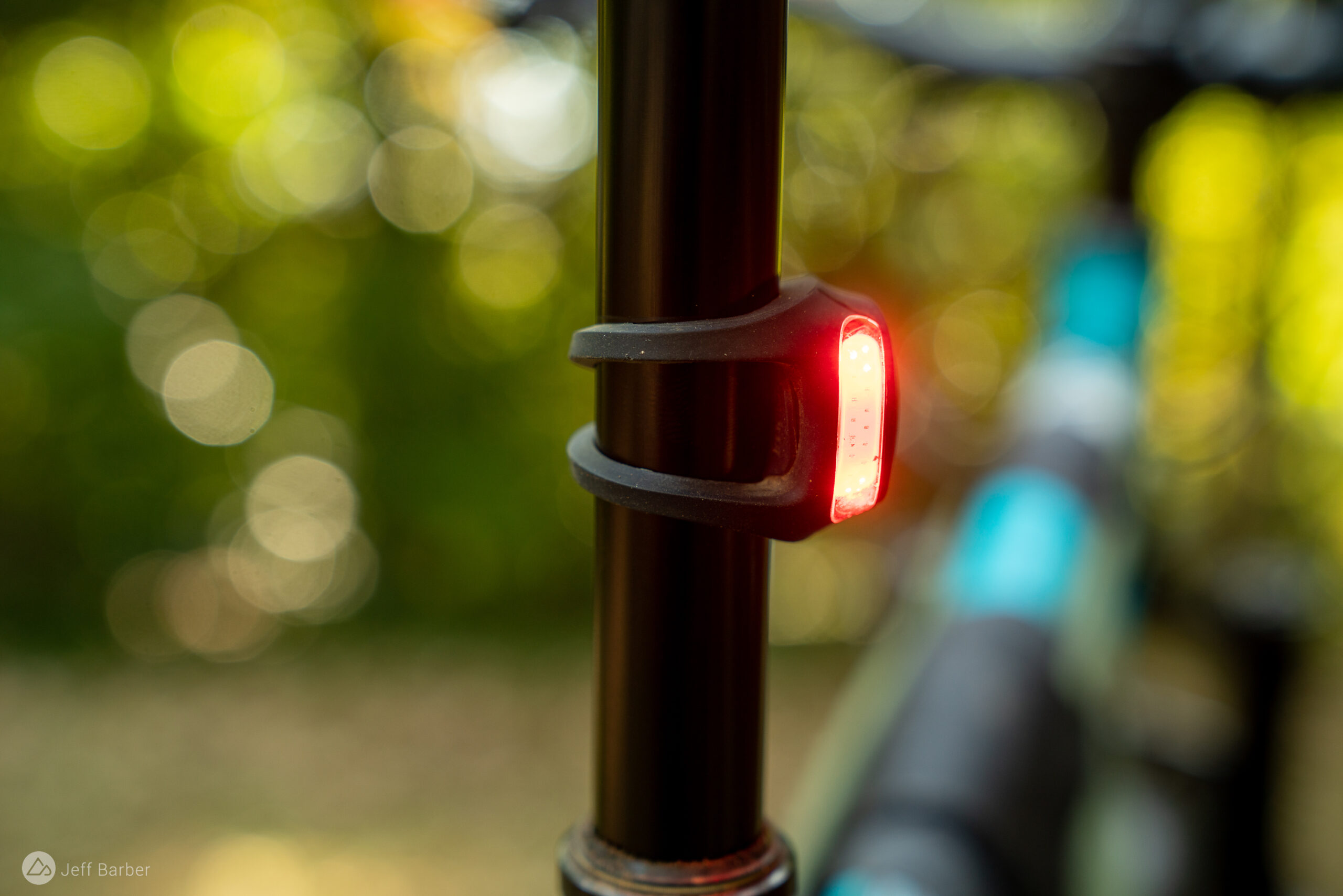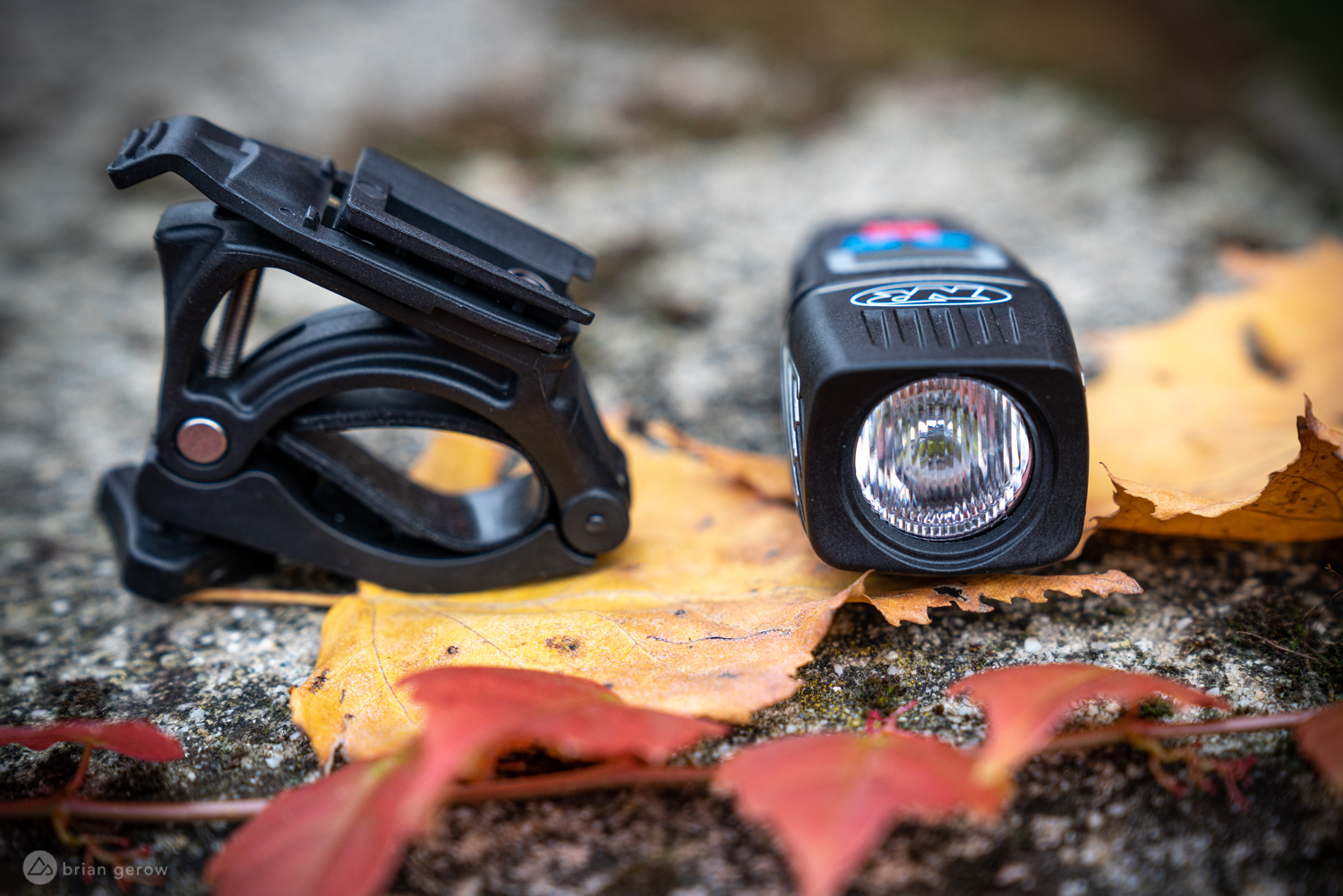
Stay on the trails longer with a headlight to brighten up the trail. Check out these mountain bike lights in a range of brightness, versatile mounting options, and beam patterns. Singletracks has tested these and dozens of other trail lights over the years and in that time, we’ve found what makes for the best night riding experience. Scroll down below the lights to learn how we evaluate bike lights for quality, value, and performance.
Curious about night riding? Start with these tips.
| Bike light | Max brightness (lumens) | Price |
|---|---|---|
| Magicshine MJ 900S | 900 | $69.99 |
| Knog Blinder 900 | 900 | $79.95 |
| PDW Lars Rover | 850 | $89.99 |
| Cateye Volt 1700 | 1700 | $129.95 |
| Outbound Hangover | ~1000 | $135 |
| Magicshine Ray 2600 | 2600 | $149.99 |
| Bookman Volume | 1500 | $149 |
| Blackburn Countdown 1600 | 1600 | $169.95 |
| NiteRider Lumina OLED 1200 Boost | 1200 | $169.99 |
| Giant Recon HL 1800 | 1800 | $175 |
| Outbound Trail EVO | ~2000 | $245 |
| Gloworm XSV G2 | 3600 | $389 |
| Light and Motion Seca 2500 Enduro | 2600 | $399.99 |
| Magicshine Monteer 8000s Galaxy | 8000 | $419.99 |

Mountain bike lights tested
Just like bikes, there are bike lights for every type of riding. The selection below includes quality bike lights that we can recommend, ordered by price. Keep in mind that the less expensive lights featured here tend to offer fewer features and shorter battery life than mid- and high-priced lights chosen.
- Best overall bike light: Outbound Hangover
- Brightest light tested: Magicshine 8000s Galaxy
- Best value bike light: Knog Blinder
- Best battery bike light: Bookman Volume 1500
- Best light for gravel biking: PDW Lars Rover

Magicshine MJ 900S
The Magicshine MJ 900S is delivers plenty of value in a small package. A single LED bulb delivers up to 900 lumens of brightness powered by an external, corded battery pack. As a helmet-mounted light, most of the weight doesn’t need to rest on your head, which we like. It also uses GoPro-style mounts so it’s easy to find a spot for it on your bike too. The Magicshine MJ 900S isn’t perfect as you can tell from our review, but it’s a good price for riders on a budget.
- Price: $69.99
- Buy from Amazon.

Knog Blinder 900
The Knog Blinder 900 offers the same size and weight advantages of many all-in-one bike headlights but with better than average battery life and a wider beam pattern for extra peripheral vision on the trail. Read a complete review of the Knog Blinder 900 bike light.
- Price: $79.95
- Buy from 365 Cycles.

PDW Lars Rover
The Lars Rover Power 850 isn’t the brightest, but it packs good power to illuminate your ride when you get caught in the dark. The well thought out mount system gives riders ease of mounting and worry free clamping that won’t rotate the light out of alignment. The easy to see LED power-meter helps to get the most running time when cycling through the five modes. We found the PDW Lars Rover is an especially good choice for gravel riding
- Price: $89.99
- Buy from Amazon


Cateye Volt 1700
The Cateye Volt 1700 features two LED bulbs for a trail-optimized beam pattern plus a swappable battery for longer night rides. At 1700 lumens, it’s very bright and the included battery promises up to two hours of runtime at the brightest setting. Read more about the Cateye Volt 1700 in our bright light throwdown.
- Price: $129.95
- Buy from Amazon.

Outbound Hangover helmet light
Mountain bikers swear by Outbound lights, and our product reviewers are impressed as well. The Hangover pumps out about 1000 lumens of adaptive brightness in a trail-specific beam pattern that’s all optimized to maximize battery life. Features USB-C charging, pass through charging, and a GoPro style mount. Read our complete review of the Outbound Hangover.
- Price: $135
- Buy from outboundlighting.com

Magicshine Ray 2600
With 2,600 lumens and two bulbs, this is a very bright helmet light. At full strength claimed battery life is just a hair over an hour and a half but we found lower settings were plenty bright and offered much more ride time. There’s even an ambient light sensor that attempts to find just the right brightness throughout your ride. Read our test review of the Magicshine Ray 2600.
- Price: $149.99
- Buy from magicshine.us

Bookman Volume 1500
The Bookman Volume 1500 features a unique brightness dial knob, but that’s not why you should choose this light. Buy the Volume 1500 for the excellent battery life, the hot swappable battery, dialed optics, and easy to use handlebar mount. Read the full Bookman Volume 1500 light review.
- Price: $149
- Buy from Amazon.
Blackburn Countdown 1600 Headlight
The Blackburn Countdown shines 1600 lumens bright and has a built-in coutdown timer that lets you know how much battery life is remaining. The tool-less mount features an easy-to-operate quick release to detach the light from the mount. Read how the Blackburn Countdown 1600 fared in our bright light throwdown.
- Price: $169.95
- Buy from Amazon and Jenson USA.
NiteRider Lumina OLED 1200 Boost
The NiteRider Lumina OLED 1200 Boost light works equally well on a handlebar or helmet mount. The beam doesn’t have a defined light space like most single-bulb lamps; instead the light spreads further and trails off at the edges. The result is a natural-feeling light source that illuminates the trail well without being overly focused. Read more in Gerow’s review of the NiteRider Lumina OLED 1200 Boost light.
- Price: $169.99 but often on sale for less
- Buy from Amazon or compare prices

Giant Recon HL 1800
The Giant Recon HL 1800 is a bright bike light at a reasonable price that spreads its beam to the sides well, making it an ideal handlebar floodlight. On the brightest setting, a main column of light shines brightly, blasting detail in the forest and at 200g it just barely slides under the maximum helmet weight mark. The beam is decidedly narrow on the lower settings, and will likely work better mounted to a helmet if riders need to get the maximum run time with fewer lumens. Read our complete Giant Recon HL 1800 review plus info about the lower powered Recon HL 800 as well.
- Price: $175
- Buy from Giant dealers

Outbound Trail EVO handlebar light
The Outbound Trail EVO is seriously bright, but the real star is the highly optimized beam pattern that lights up the trail like no other. Outbound put a lot of thought into the mount as well so it’s easy to position on your bars. Read the full review of the Outbound Trail EVO light, which we paired with the Hangover helmet light.
- Price: $245
- Buy from outboundlighting.com
Gloworm XSV Light Set (G2.0)
If you’re not sure what you’re missing with the inexpensive bike lights found online, just check the Gloworm XSV G2 feature set. With customizable brightness modes and optics, a long-lasting battery, well-considered plugs and cables, and a flexible mounting system, this is a high-end bike light system that won’t leave buyers squinting for more.
- Price: $389
- Buy from glowormlites.co.nz and Jenson USA.
Light and Motion Seca 2500 Enduro
Where some high-powered mountain bike lights operate as a massive battering ram to blast everything with glow, the Seca Enduro has a more refined beam that spreads out just enough to make the trail safe without wasting energy illuminating things that the rider doesn’t need to see. It provides more than enough light for the fastest descents on the 1250Lm setting, saving some extra power for foggy or otherwise low visibility conditions. The two-piece system can be mounted to a helmet or handlebar. Read a more in-depth review of the Light and Motion Seca 2500 Enduro bike light.
- Price: $399.99
- Buy from Amazon and Backcountry.
Magicshine Monteer 8000s Galaxy Light
The Magic Shine Monteer 8000s Galaxy bike light is what you will want mounted to the front of a tractor for night farming, or strapped to the hood of your car if the headlights go out. This thing is about 8x as powerful as most mountain bikers need, though anyone who needs it can dump 8000Lm into the forest for a full 90 minutes. Yes, it’s heavy. But if you need a seriously bright light, it’s worth the weight. Read Gerow’s complete review of the Magicshine Monteer 8000s Galaxy light.
- Price: $419.99
- Buy from Amazon
How to choose the best mountain bike lights
Before you choose a light for mountain biking, it’s important to consider the types of trails you’ll be riding at night and the speeds you expect to carry. For example, if the trails you’ll be riding are technical, you’ll want a brighter light with better fill than if you’ll be riding wide dirt paths. And if you want to go fast, you’ll need a light with more range (i.e. power) than if you expect to slow things down in the dark. Also keep in mind how often you’ll be night riding; if it’s only once or twice a month in the winter you may not want to sink a ton of money into a light system.

Where should you mount your bike light?
There are basically two choices here: bar mount and helmet mount.
A helmet-mounted light tracks wherever you’re looking: around a switchback–at a rough patch of trail, etc.–which many riders prefer. The trade-off is that helmet mounted lights can feel heavy on the head, which some riders have a hard time getting used to. Remember, with a two-piece, helmet-mounted light you’ll need to strap the battery pack to the helmet itself or stash the battery in a jersey pocket, which can harsh your flow on the trail. Lights are typically mounted to a vented helmet using velcro or stretchy straps or GoPro mounts. Helmet-mounted lights will shine down on the trail more, which is good at eliminating some shadows but shortens the distance the light will carry forward.

Bar mounted light arrangements may vary, and some are better than others at dealing with tapered bars and varied bar diameters (look for ones with rubber straps or a clamp with plenty of screw length, especially if you have 35mm diameter bars). Batteries can be mounted separately, and most riders choose to place them under the stem or in the frame triangle below the top tube. A light at bar height will shine farther down the trail, but will tend to produce more shadows in uneven terrain.
Many small- to medium-sized light kits, especially those with an all-in-one design include hardware for both helmet and bar mounting, so you can see which one works best for you. Of course, the best of both worlds is to ride with both a helmet and bar light but for beginning night riders, a medium-power helmet lamp is a good start.

Bike light brightness
To compare brightness between light systems, check the number of lumens (some brands may claim competitors’ lumen counts are flawed, but it’s still a good starting point). At a minimum you’ll want about 800 lumens to ride trails at night, though you won’t need to use the light at full brightness all the time. For more technical trails and reasonably-fast descending, 1,000+ lumens is better. Of course, you can buy lights that are as bright as 6,000 lumens!
Beyond lumen counts, the actual beam pattern is important to consider. The simplest pattern is a round one (since LED bulbs are round), but much of that light is wasted on the edges of the trail. Some lights offer a round beam pattern with a center “hot spot” and a diffused outer halo that’s good at illuminating your peripheral vision while highlighting what’s ahead. A well thought out beam pattern on a bar mounted light system all but makes up for the fact that your light doesn’t follow your eyes like with a helmet-mounted system.
Most lights feature multiple light modes (high, medium, low, strobe, etc.) and some even offer customizable light modes. Strobe settings are designed for commuting and dusk rides where you’re more concerned about being seen than actually seeing the path ahead.
Bike light batteries
The heart of any light system is the battery, so it’s important to pay attention to quality and reliability. Almost all bike lights include a rechargeable Li-ion battery. Charge times can vary widely (from as little as 2.5 hours to 10+ hours), so be sure to check–there’s nothing worse than forgetting to charge your light the day of a big ride. Be sure to follow the manufacturer’s charging instructions to maximize the life of your battery. Most lights use a USB port for charging so you don’t have to worry about keeping track of proprietary chargers. The downside is these can be slow to charge, especially connected to a laptop or low-power phone charger.
Longer battery life comes with a trade-off: the batteries are heavier and more expensive. Look for run times on high that are at least long enough for your typical ride (we look for 2 hours minimum). To compare systems, it can be helpful to calculate a simple ratio of max lumens to run time on high. For example, if a 300 lumen light gets 4 hours of run time (240 minutes), that’s 0.8 lumens per minute (this number doesn’t mean anything–it’s just for comparison). If another light’s ratio is 1 lumen per minute, that means the second light is more efficent (holding other things like battery size/weight constant).
Because batteries will degrade over time and technology is changing rapidly, we don’t recommend purchasing used bike lights unless you’re able to test and verify actual run time yourself.

Bike tail lights
It’s always a good idea to bring along a blinking red tail light on any night ride, even if you don’t expect to encounter any cars. Choose a bright, inexpensive light that can be easily strapped onto a hydration pack or attached to your seatpost.
Gravel bike lights
Some mountain bike lights work better than other for gravel and drop bar bikes. An all-in-one light with 800 lumens is more than enough brightness. Lights with wider beam patterns tend to work well for gravel riding. Be sure to make sure included handlebar mounts will fit smaller diameter gravel bars, and consider a dual-purpose mount if you’re limited for space. One bike light we like for gravel biking is the PDW Lars Rover.
Want to find the best price on your next mountain bike? Try our comparison shopping tool and don’t miss our Weekly MTB Deals for the biggest savings on mountain bikes, gear and more.

























1 Comments
Dec 10, 2023